In general, caching can improve performance by storing data so future requests for the same data are served faster. For example, a cached resource from the network can avoid a round trip to the server. A cached computational result can omit the time to do the same calculation.
In Chrome, the cache mechanism is used in various ways and HTTP Cache is one example.
How Chrome's HTTP Cache currently works
As of version 85, Chrome caches resources fetched from the network, using their respective resource URLs as the cache key. (A cache key is used to identify a cached resource.)
The following example illustrates how a single image is cached and treated in three different contexts:
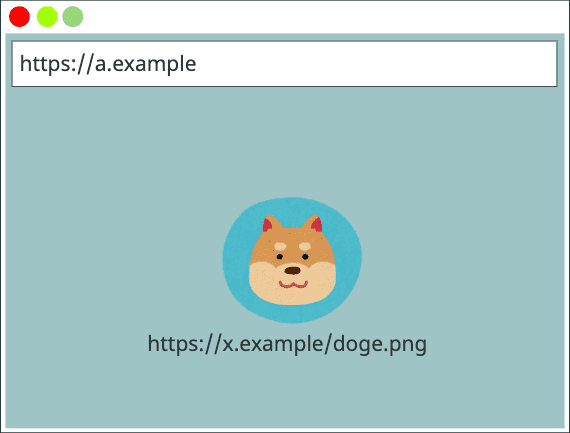
https://x.example/doge.png }
A user visits a page (https://a.example) that requests an image
(https://x.example/doge.png). The image is requested from the network and
cached using https://x.example/doge.png as the key.

https://x.example/doge.png }
The same user visits another page (https://b.example), which requests the same
image (https://x.example/doge.png).
The browser checks its HTTP Cache to see
if it already has this resource cached, using the image URL as the key. The
browser finds a match in its Cache, so it uses the cached version of the
resource.
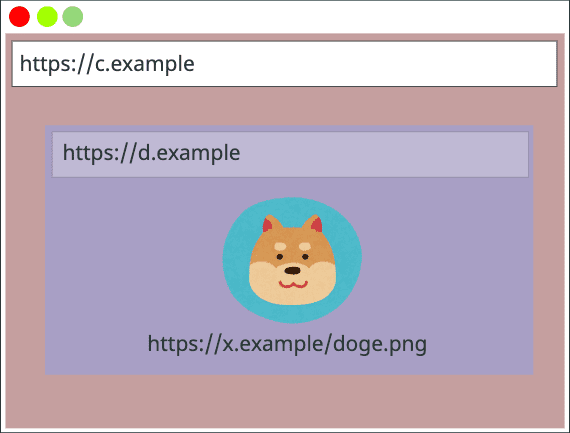
https://x.example/doge.png }
It doesn't matter if the image is loaded from within an iframe. If the user
visits another website (https://c.example) with an iframe
(https://d.example) and the iframe requests the same image
(https://x.example/doge.png), the browser can still load the image from its
cache because the cache key is the same across all of the pages.
This mechanism has been working well from a performance perspective for a long time. However, the time a website takes to respond to HTTP requests can reveal that the browser has accessed the same resource in the past, which opens the browser to security and privacy attacks, like the following:
- Detect if a user has visited a specific site: An adversary can detect a user's browsing history by checking if the cache has a resource which might be specific to a particular site or cohort of sites.
- Cross-site search attack: An adversary can detect if an arbitrary string is in the user's search results by checking whether a 'no search results' image used by a particular website is in the browser's cache.
- Cross-site tracking: The cache can be used to store cookie-like identifiers as a cross-site tracking mechanism.
To mitigate these risks, Chrome will partition its HTTP cache starting in Chrome 86.
How will cache partitioning affect Chrome's HTTP Cache?
With cache partitioning, cached resources will be keyed using a new "Network Isolation Key" in addition to the resource URL. The Network Isolation Key is composed of the top-level site and the current-frame site.
Look again at the previous example to see how cache partitioning works in different contexts:
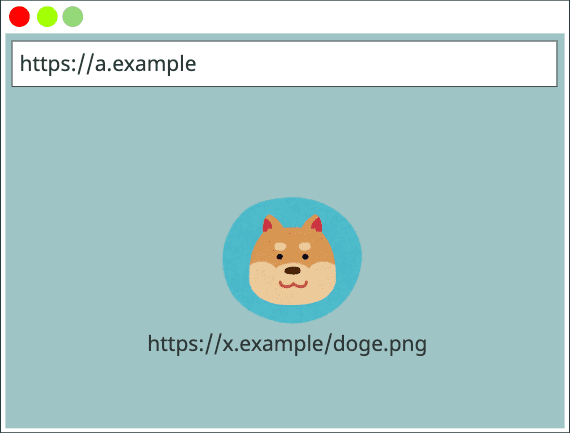
https://a.example, https://a.example, https://x.example/doge.png }
A user visits a page (https://a.example) which requests an image
(https://x.example/doge.png). In this case, the image is requested from the
network and cached using a tuple consisting of https://a.example (the top-level site),
https://a.example (the current-frame site), and https://x.example/doge.png (the
resource URL) as the key. (Note that when the resource request is from the
top-level -frame, the top-level site and current-frame site in the Network
Isolation Key are the same.)
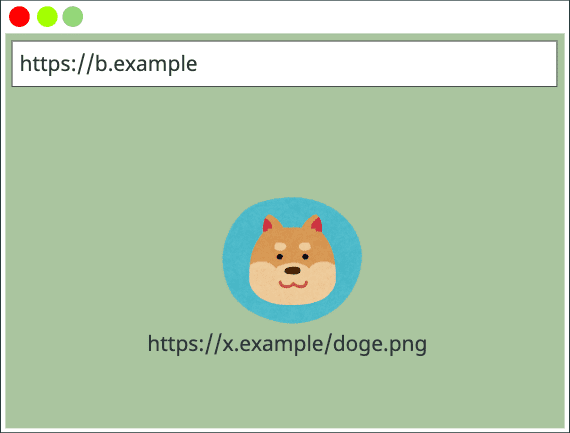
https://b.example, https://b.example, https://x.example/doge.png }
The same user visits a different page (https://b.example) which requests the
same image (https://x.example/doge.png). Though the same image was loaded in
the previous example, since the key doesn't match it will not be a cache hit.
The image is requested from the network and cached using a tuple consisting of https://b.example,
https://b.example, and https://x.example/doge.png as the key.
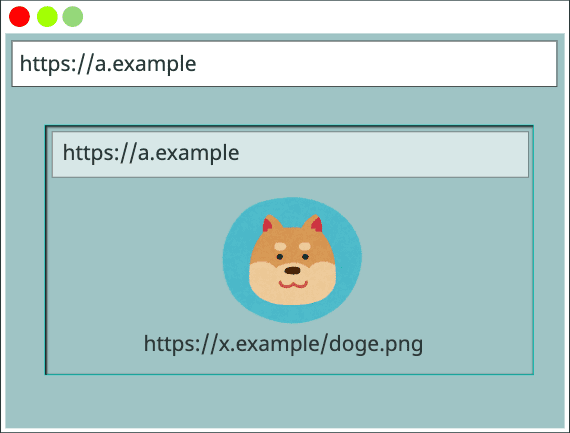
https://a.example, https://a.example, https://x.example/doge.png }
Now the user comes back to https://a.example but this time the image
(https://x.example/doge.png) is embedded in an iframe. In this case, the
key is a tuple containing https://a.example, https://a.example, and https://x.example/doge.png
and a cache hit occurs. (Note that when the top-level site and the iframe are
the same site, the resource cached with the top-level frame can be used.
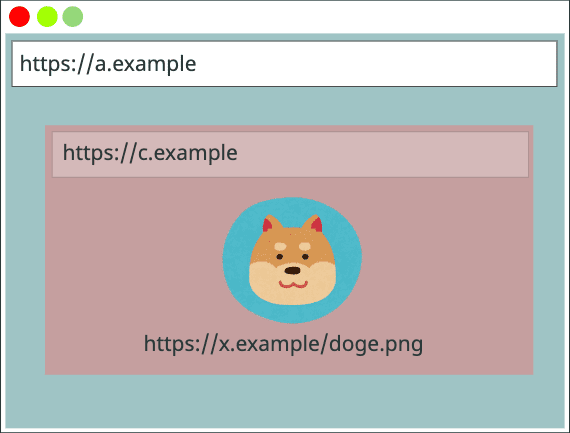
https://a.example, https://c.example, https://x.example/doge.png }
The user is back at https://a.example but this time the image is hosted in an
iframe from https://c.example.
In this case, the image is downloaded from the network because there is no
resource in the cache that matches the key consisting of https://a.example,
https://c.example, and https://x.example/doge.png.
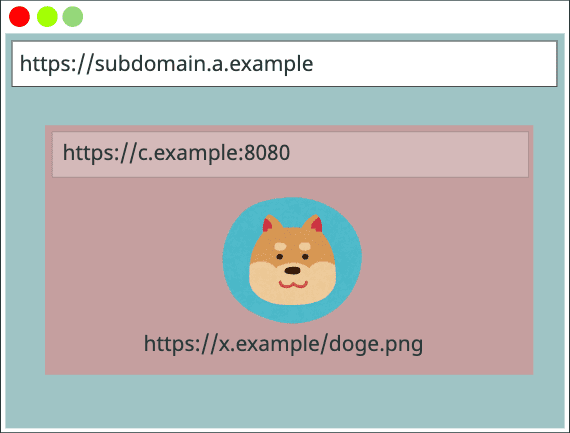
https://a.example, https://c.example, https://x.example/doge.png }
What if the domain contains a subdomain or a port number? The user visits
https://subdomain.a.example, which embeds an iframe
(https://c.example:8080), which requests the image.
Because the key is created based on "scheme://eTLD+1", subdomains and port numbers are ignored. Hence a cache hit occurs.
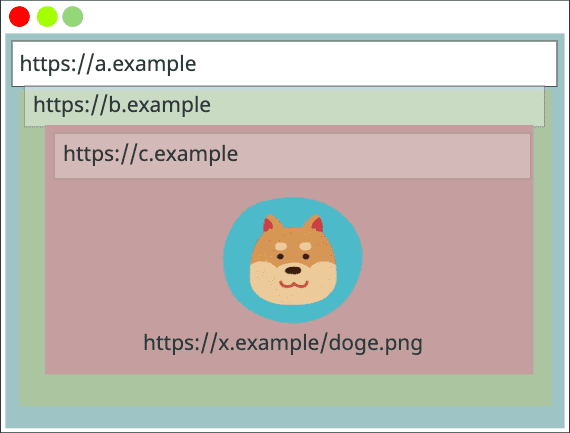
https://a.example, https://c.example, https://x.example/doge.png }
What if the iframe is nested multiple times? The user visits
https://a.example, which embeds an iframe (https://b.example), which embeds
yet another iframe (https://c.example), which finally requests the image.
Because the key is taken from the top-frame (https://a.example) and the
immediate frame which loads the resource (https://c.example), a cache hit
occurs.
FAQs
Is it already enabled on my Chrome? How can I check?
The feature is being rolled out through late 2020. To check whether your Chrome instance already supports it:
- Open
chrome://net-export/and press Start Logging to Disk. - Specify where to save the log file on your computer.
- Browse the web on Chrome for a minute.
- Go back to
chrome://net-export/and press Stop Logging. - Go to
https://netlog-viewer.appspot.com/#import. - Press Choose File and pass the log file you saved.
You will see the output of the log file.
On the same page, find SplitCacheByNetworkIsolationKey. If it is followed by
Experiment_[****], HTTP Cache partitioning is enabled on your Chrome. If it is
followed by Control_[****] or Default_[****], it is not enabled.
How can I test HTTP Cache partitioning on my Chrome?
To test HTTP Cache partitioning on your Chrome, you need to launch Chrome with a
command line flag: --enable-features=SplitCacheByNetworkIsolationKey. Follow
the instruction at Run Chromium with flags to
learn how to launch Chrome with a command line flag on your platform.
As a web developer, are there any action I should take in response to this change?
This is not a breaking change, but it may impose performance considerations for some web services.
For example, those that serve large volumes of highly cacheable resources across many sites (such as fonts and popular scripts) may see an increase in their traffic. Also, those who consume such services may have an increased reliance on them.
(There's a proposal to enable shared libraries in a privacy-preserving way called Web Shared Libraries (presentation video), but it's still under consideration.)
What is the impact of this behavioral change?
The overall cache miss rate increases by about 3.6%, changes to the FCP (First Contentful Paint) are modest (~0.3%), and the overall fraction of bytes loaded from the network increases by around 4%. You can learn more about the impact on performance in the HTTP cache partitioning explainer.
Is this standardized? Do other browsers behave differently?
"HTTP cache partitions" is standardized in the fetch spec though browsers behave differently:
- Chrome: Uses top-level scheme://eTLD+1 and frame scheme://eTLD+1
- Safari: Uses top-level eTLD+1
- Firefox: Planning to implement with top-level scheme://eTLD+1 and considering including a second key like Chrome
How is fetch from workers treated?
Dedicated workers use the same key as their current frame. Service workers and shared workers are more complicated since they may be shared among multiple top-level sites. The solution for them is currently under discussion.

